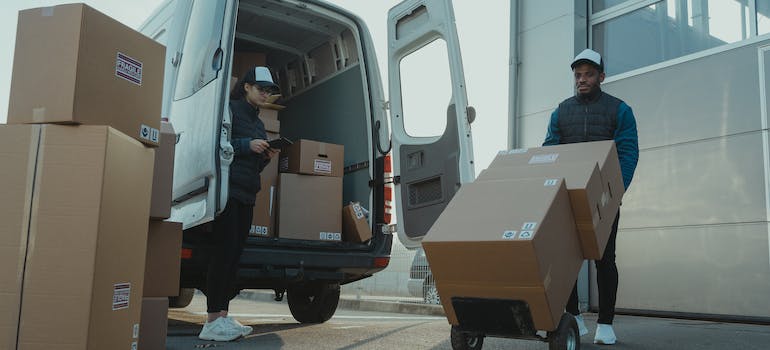Innovations Tackling Last-Mile Delivery Challenges in the SMA
The rapid growth of e-commerce and the urban density of the Seattle Metro Area (SMA) pose significant challenges for last-mile delivery – the final step of the delivery process. The unique geographic constraints, coupled with high consumer demand for speedy deliveries, make SMA a hotbed for logistical innovation. In the hope of assisting you in understanding and overcoming the last-mile delivery challenges in the SMA, this Hansen Bros. Moving & Storage article explores the cutting-edge innovations that local businesses and startups are deploying to address these matters effectively.
Overview of the Last-Mile Delivery Challenges in the SMA
The Seattle Metro Area is a bustling hub of commerce and innovation. Yet, it is not immune to the complexities of last-mile delivery – a critical phase in the logistics network. With many obstacles ranging from severe traffic congestion to strict environmental regulations and high consumer expectations, the SMA’s delivery systems are in a constant state of adaptation and evolution. These challenges are not only significant in their own right, but they also set the stage for innovative solutions.
Traffic Congestion and Urban Density
The confluence of dense urban landscapes and a surging demand for quick deliveries makes SMA’s traffic congestion a critical issue to tackle. Delivery services are navigating a maze of slow-moving traffic, directly impacting their efficiency and service quality.
Overview of traffic patterns in the SMA
The ebb and flow of the SMA’s traffic are well-documented, with peak hours extending far beyond the typical “rush hour.” This sustained congestion requires delivery services to strategize their dispatch times and routes meticulously to avoid costly delays.

Impacts of congestion on delivery times and costs
The perennial stop-and-go traffic not only prolongs delivery times but also inflates operational costs. Fuel consumption and labor costs rise as drivers spend more time on the road to complete each delivery. Moreover, these delays can lead to a ripple effect, disrupting the tightly scheduled world of shipping companies in Seattle and ultimately affecting the end consumer’s experience.
Environmental Regulations and Sustainability Goals
Seattle’s environmental consciousness is more than a cultural touchstone; it shapes the regulatory framework within which last-mile delivery operations must function. These regulations and sustainability goals, while essential for preserving the SMA’s natural beauty and the well-being of its residents, present unique challenges for the logistics sector.
SMA’s policies impacting fleet operations
The SMA enforces various environmental policies that directly affect delivery fleet operations. These include emissions standards that may restrict the use of older, less efficient delivery vehicles and zoning laws limiting access to certain areas during specified times. Delivery companies must upgrade their fleets to meet these standards, which requires substantial investment in newer, eco-friendly vehicles.
The push towards green logistics
Sustainability initiatives in Seattle extend beyond regulatory compliance. There is a significant push for green logistics to reduce the carbon footprint of delivery operations. This initiative includes:
- Exploring alternative fuels;
- Investing in electric and hybrid vehicles;
- Adopting bicycles or foot couriers for shorter delivery routes.
These strategies are not only environmentally responsible but are also increasingly expected by consumers, who often prefer to patronize businesses with a demonstrated commitment to sustainability.
Managing Consumer Expectations
In the fast-paced market of the Seattle Metro Area, customer anticipations set a high bar for delivery services. The immediacy of online shopping has reshaped what consumers consider a standard level of service, pushing delivery and freight companies Seattle offers to their operational limits.
Demand for same-day and instant deliveries
The expectation for rapid delivery services in Seattle Metro has escalated to where same-day and even instant deliveries are becoming the norm. To keep up and overcome these last-mile delivery challenges in the SMA, logistics companies must streamline their operations, enhancing speed without sacrificing reliability or accuracy.

The effect of delivery experiences on consumer loyalty
In the delivery business, every package not only represents a transaction but also an opportunity to solidify customer trust. A seamless and swift delivery experience is paramount to nurturing loyalty. Any deviation from this can quickly erode consumer confidence, making it imperative for companies to ensure a consistently positive delivery experience.
Geographic and Infrastructure Limitations
The distinctive landscape and infrastructure of the Seattle Metro Area present additional layers of complexity to last-mile delivery. The natural and built environment of SMA, characterized by its waterways, steep hills, and historic districts, poses logistical puzzles for delivery companies to solve.
The SMA’s unique topography
Seattle’s topography, marked by its undulating terrain and expansive bodies of water, creates natural barriers to direct travel routes. Delivery services must carefully plot courses that navigate around these physical constraints, often resulting in longer, less efficient paths that can delay delivery times and increase costs.
Limitations of existing infrastructure on delivery efficiency
The SMA’s infrastructure, much of which was designed well before the current demands of e-commerce, is frequently mismatched with the needs of modern delivery fleets. Narrow roadways, limited parking, and aging bridges are not conducive to large delivery vehicles or the rapid pace of delivery services. These infrastructural constraints impede the flow of goods and add to the challenge of international commercial shipping companies meeting the expected delivery windows.
Influence of the COVID-19 Pandemic on Consumption Patterns
The onset of the COVID-19 pandemic marked an unprecedented shift in consumer behavior and posed new challenges for last-mile delivery services in the Seattle Metro Area. With the health crisis influencing every aspect of commerce, delivery systems had to quickly adapt to a new landscape marked by a surge in demand and a heightened expectation for contactless interactions.

The surge in online shopping
As the pandemic took hold, residents of the SMA increasingly turned to online shopping, a shift that led to a significant uptick in the volume of deliveries. This surge required last-mile delivery providers to scale their operations rapidly while maintaining service quality. The increased demand also stressed the existing supply chains, pushing the limits of logistics networks and accelerating the need for innovative delivery solutions.
The need for contactless delivery options
In response to health and safety concerns, contactless delivery became not just a preference but a necessity for many consumers. This transition necessitated the development and implementation of new protocols and technologies that allowed for deliveries to be completed with minimal human-to-human interaction.
Solutions ranged from simple measures, such as leaving packages at a safe distance from the door, to more sophisticated systems, like secure locker pickups and advanced package tracking, to ensure the safety and convenience of both customers and delivery personnel.
The pandemic’s challenges required last-mile delivery services in the SMA to be agile and responsive to rapidly changing circumstances. It has catalyzed a transformation in the logistics industry that continues to influence how companies approach delivery challenges and customer satisfaction in the post-pandemic era.
Innovations Addressing Last-Mile Delivery in the SMA
In response to the intricate web of last-mile delivery challenges in the SMA, a host of innovative solutions have emerged. The embrace of cutting-edge technology has enabled delivery services to refine their operations, ensuring they are more efficient, sustainable, and customer-centric than ever before. Hence, the key innovations include:
- Technological Advancements: Leveraging AI and IoT for enhanced routing and tracking.
- Sustainable Solutions: Adopting eco-friendly vehicles and practices to meet environmental regulations.
- Infrastructure Improvements: Upgrading and creating urban logistics hubs to streamline last-mile delivery, reducing distances and enhancing delivery speed.
- Collaborative Logistics: Embracing shared economy models to optimize resource usage.
- Policy and Planning: Strategically designing regulations and urban infrastructure to accommodate and encourage efficient last-mile delivery solutions.
These technological and strategic innovations mark a significant shift towards a smarter, more agile last-mile delivery network well-equipped to overcome the region’s unique challenges.

Technological Advancements
At the forefront of tackling the SMA’s delivery obstacles are technological advancements that streamline operations and redefine efficiency.
Use of AI and Machine Learning for route optimization
Artificial intelligence and machine learning have become the linchpins of route optimization, with their ability to process complex data and provide actionable insights. These tools can dynamically adjust delivery paths in response to real-time traffic updates, road closures, and even the historical performance of routes, significantly reducing delivery times and operational costs.
Deployment of IoT for real-time tracking and fleet management
The deployment of the Internet of Things technology has turned delivery fleets into interconnected webs of information. IoT devices track the location, speed, and condition of delivery vehicles, offering an unprecedented level of oversight. This real-time data stream empowers businesses to optimize fleet performance and quickly address logistical hiccups.
Sustainable Solutions
In a world increasingly focused on environmental responsibility, the Seattle Metro Area has proactively participated in integrating sustainable solutions within its last-mile delivery operations. These green innovations are not merely about adherence to regulations. They represent a commitment to preserving the city’s natural beauty and fostering a healthier urban life.
Electric and alternative fuel vehicles
Electric vehicles (EVs), with their zero emissions capability, have become a central component of the sustainable delivery fleet. Companies are steadily replacing gas-powered vans and trucks with EVs, greatly reducing their carbon footprint. Beyond EVs, other alternative fuel vehicles, like those powered by compressed natural gas or biodiesel, also contribute to a cleaner delivery process.
Bicycle and foot courier networks
For urban centers within the SMA, bicycle, and foot couriers present an eco-friendly alternative to motorized transport. This human-powered delivery method is environmentally sustainable, reducing the carbon footprint associated with traditional vehicles.
Package consolidation and optimized loading
Innovations in logistics software have enabled smarter package consolidation and vehicle loading techniques. Maximizing the cargo in each trip allows delivery services to decrease the number of vehicles on the road, thus lowering overall emissions and improving traffic conditions.

Infrastructure Improvements
In the heart of the Seattle Metro Area’s approach to refining last-mile delivery, infrastructural upgrades play a crucial role. Enhancements are geared towards reducing delivery times, reducing traffic congestion, and increasing overall efficiency.
Development of urban consolidation centers (UCCs)
The SMA has seen the development of Urban Consolidation Centers as a strategic move to decongest urban delivery routes. These centers are pivotal in streamlining goods flow by serving as collection and distribution hubs, thus facilitating fewer delivery trips and promoting eco-friendly delivery methods within urban cores.
The deployment of micro-fulfillment centers throughout the SMA represents a significant stride in bringing products closer to the end consumer. These centers support a rapid delivery model by allowing for shorter last-mile distances, essential in dense urban environments where each mile saved can significantly impact delivery speed and reduce carbon emissions.
Collaborative Delivery Models
Collaboration is key in modernizing last-mile logistics, and the SMA has embraced this concept by fostering innovative delivery models. Such collaborative approaches reconfigure the delivery method, making it more adaptable and resource-efficient.
Crowd-sourced delivery platforms
The rise of crowd-sourced delivery platforms has harnessed the gig economy to distribute the delivery load. These platforms contribute to a scalable workforce, accommodating fluctuating delivery demands without needing a fixed infrastructure, thereby optimizing resource use and reducing overhead costs.
Partnerships between retailers for shared delivery services
Strategic partnerships between retailers have unfolded as a method to consolidate delivery efforts. By sharing delivery networks, retailers can optimize routes, share logistical costs, enhance service levels, and utilize Seattle storage together, providing a win-win scenario for businesses and consumers.

Policy and Planning Easing Last-Mile Delivery Challenges in the SMA
Integrating last-mile delivery into urban policy and planning is essential for sustainable growth, and the SMA is actively pursuing this integration. Such efforts ensure that the infrastructural and collaborative innovations are supported by a framework that promotes efficiency and sustainability.
Coordination with local government for smart city initiatives
The SMA’s collaboration with local government bodies has led to smart city initiatives that underpin last-mile delivery innovations. This includes policies that support the development of UCCs and micro-fulfillment centers, as well as the adoption of crowd-sourced delivery models.
Urban planning for delivery-friendly environments
Urban planning efforts are being tailored to facilitate last-mile delivery operations. This includes:
- designating areas for UCCs,
- creating spaces for micro-fulfillment centers, and
- planning city layouts that accommodate the unique needs of modern delivery systems.
Through these concerted efforts in infrastructure, collaborative models, and policy, the SMA is carving a path toward a more efficient and sustainable future in last-mile delivery.
Beyond Today’s Last-Mile Innovations in the SMA
These innovations are just the starting point in tackling last-mile delivery challenges in the SMA. As these advancements grow and become more integrated into the last-mile delivery ecosystem, they hold the promise of reshaping the efficiency, sustainability, and customer satisfaction landscape of urban logistics. The ongoing refinement of these solutions continues to lessen the burden of last-mile delivery challenges, paving the way for an optimized logistics framework that could serve as a benchmark for metropolitan areas worldwide.
Why Choose Us
History
Hansen Bros. Moving & Storage is locally owned and operated by the same family for four generations, since 1890. We have a well-established reputation for service quality and reliability with a high percentage of repeat household and commercial clients.
Professionalism
We’re a certified ProMover by the American Moving and Storage Association with A+ rating with the Better Business Bureau, voted “Best in Western Washington” in 2009 and from 2011 to 2016 by KING5. Our company is fully licensed and insured and member of WMC and AMSA.
Value
Hansen Bros. Moving & Storage provide free, no-obligation in-home estimate and competitive rates, including low minimum rates for shipments moving under 300 miles. We’ve set a refund policy for unused packing materials and three Puget Sound locations to help clients save on travel fee costs.



